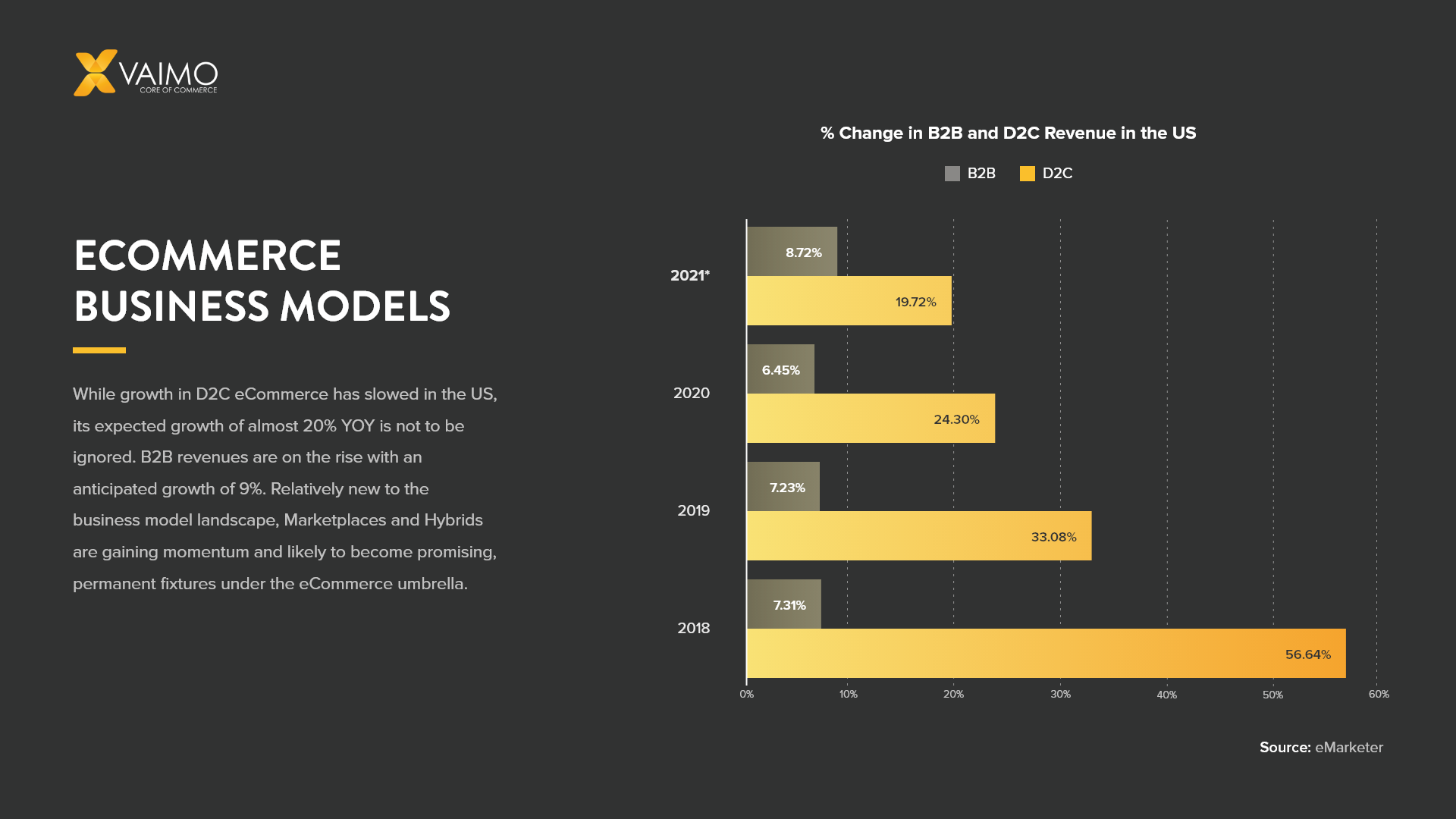As the world awakened to eCommerce during the pandemic, many companies recognized the need to adapt their digital commerce business models to optimize their reach and take advantage of the trend. But while “digital disruption” is a wildly popular term, it is riddled with irony: in a way, it isn’t real. As Christian Dreisbach shared in a recent piece, “So-called ‘digital disruption’ is just the modern world, turning its wheels, constantly moving ever forward”. It is not a new trend—it is simply reality.
But with so much ambiguity, it’s no wonder that most businesses struggle with where to invest their resources. In fact, the lack of clarity also mistakenly leads many companies to create false perceptions of their need for a digital commerce business model: in 2021, less than two-thirds of small businesses have a website, while 41% of small businesses claim they do not need a website. But with consumers riding the wave and spending more online than ever before, businesses must awaken to the reality.
And so, many companies feel that they are looking in the rearview mirror, trying to distinguish just how many eCommerce models are out there and how to choose the one that is best for their business – the one that will drive that much sought after “seamless customer experience”, AND align with their digital business goals.
But before we get into the models, it is important to ask a few questions first. If the eCommerce trends of 2021 have taught us anything, it is that a good digital commerce strategy starts with the basics. Without solidifying a few simple answers, businesses lack the clarity that is crucial to ensure a successful transformation and create forward momentum.
So, where do we begin? By answering these questions:
- Who is your customer? What do you know about them? What are they like? What are their expectations when purchasing the products or services your business provides?
- What does your business provide, and how is your product or service unique? Depending on your product, some models will serve you better than others. Build around your existing strengths and the customers that are already energizing you.
- Where are your customers located? Are they both geographically local and online? How will they find you?
- How do you reach your customers most effectively? In addition to expanding your customer base, you want to be able to share what makes your product the superior choice. Check your competition and determine what makes you stand out – do you offer a better price? Selection? Convenience? How do you communicate that information and drive potential buyers to your eCommerce site?
With these basic questions answered, we can now move ahead and explore the five different models, breaking them down to help you make an informed and empowered choice. We will be taking a look at:
- B2C, or business to consumer models
- B2B, or business to business models
- D2C, or direct-to-consumer models
- Marketplaces (think Amazon, but we will explore this further), and
- Hybrids
Let’s dig in!
B2C (Business to Consumer)
A B2C model is when a company markets its products or services directly to end-users and is what most people think of when they think of an eCommerce business. Traditionally it is the deepest market, and many of the names you see online are also well known offline. B2C eCommerce is the traditional retail model where a business sells to individuals, but those transactions are conducted online as opposed to in a physical store.
In B2C commerce, the primary challenge for merchants lies in creating a fast and intuitive user experience while simultaneously cultivating emotional connections and long-lasting relationships with customers. But there is another important consideration: the consumers’ decision-making process for B2C purchases is more immediate than what we might see in other models. Because of this shorter sales cycle, B2C businesses typically spend fewer marketing dollars to make a sale. Regardless of whether your business includes products or services, successful B2C brands understand the importance of leveraging various digital marketing techniques, such as Google Search and Shopping, retargeting and social, to market directly to their customer base and drive traffic to their selected products.
Additionally, categories such as grocery eCommerce and delivery rely more heavily on mobile apps to place orders, track delivery routes, text customers, and process credit card payments on the go, benefitting both the consumer and business.
B2B (Business to Business)
A B2B eCommerce model is when an online order or transaction occurs between businesses such as wholesalers, manufacturers, or distributors. Interestingly, there can be a B2C component to B2B models where services are sold to the consumer, but the business is the broker of the products (to another business) and the service (e.g., installation to the consumer). The global B2B eCommerce market was recently valued at $12.2 trillion—or six times as much as the B2C market and continues to see close to double-digit growth YOY.
With those kinds of numbers, it is obvious that B2B is currently a robust market. But what is especially exciting is that it is growing at unprecedented rates as more and more business buyers congregate online. American B2B eCommerce transactions are expected to reach $1.8 trillion by 2023, which would account for 17% of all B2B sales in the country. But it gets even better—it is currently predicted that by 2025, 80% of all B2B sales interactions between suppliers and business buyers will take place online.
B2B eCommerce has the potential to permanently change the playing field for the brands involved. And while B2B has traditionally been more labor-intensive than its B2C counterpart (involving costly manual sales and marketing strategies), eCommerce helps automate and improve efficiency, thereby reducing costs. Much like the individual consumer, many businesses appreciate the simplicity of ordering online as opposed to working with a sales representative. By including smart strategies in your B2B marketing plans, your business can expect to reach a larger audience while participating in one of the fastest-growing markets.
D2C (Direct-to-Consumer)
One of the newer eCommerce business models, a D2C transaction takes place when a manufacturer sells its product directly to the consumer without using a distributor or retailer. This is where the important distinction between D2C and B2C comes in—D2C differs in that manufacturers sell directly to consumers while B2C usually relies on a retailer stepping in between a manufacturer and customers. You can think of D2C as an updated mail order catalog for the digital age.
In some cases, a brand is born solely as D2C, such as the Dollar Shave Club. In other situations, an existing (often well-established) brand enters the D2C market later in the game, increasing their market share, such as PepsiCo. Still, others are born as D2C and wind up selling products through retailers down the road, such as UNTUCKIT.
As we’ve mentioned in the past, D2C is a popular choice for brands that want to enter the market quickly and with a lower entry-level cost. With the rise of eCommerce, more and more businesses are seeing the opportunity to go direct and sell directly to the consumer, thus cutting out the middleman and lowering costs. There has been explosive growth in D2C over the past three years from a high of 57% in 2018. In fact, growth in the D2C market holds great promise for certain consumer segments. While only 4% of millennials prefer D2C brands over traditional retailers, this grows to a whopping 40%-45% for Gen Z-ers. With trends shifting rapidly and younger generations expressing different needs and expectations when it comes to how they prefer to shop, the D2C model should be considered very seriously when looking at your own eCommerce strategy AND the answers to those questions above.
Marketplaces
At their most basic level, online marketplaces connect buyers and sellers on a proprietary platform. Most often, the marketplace operator does not hold any type of inventory but rather helps buyers and sellers facilitate a transaction. A marketplace’s operator usually performs tasks such as handling logistics or facilitating payment, thus allowing sellers (merchants) to focus on their core competency: providing customers with the most relevant products.
While it may seem abstract, eCommerce marketplaces play a huge role in the overall eCommerce landscape. These platforms can facilitate tremendous exposure for a company (and the sellers), thus resulting in massive sales. In fact, the average sales price of a third-party Amazon business leaped by about 80% between 2019 and 2020, jumping from $298,558 to $538,742.
Many people are incredibly familiar with the marketplace model in B2C, thanks to AMAZON. Amazon sells other merchants’ inventory (and their own) directly to customers while making 50% of revenue from commissions taken from vendors selling out of the marketplace.
A relatively recent twist on the marketplace model in B2C is typified by etsy.com, where the marketplace operator does not own any merchandise but rather simply offers a platform for other people to use. By doing so, inventory risk is removed, and these marketplace owners make money by taking a commission from each sale.
Covid has demonstrated how critical online consumer services and technology are for many aspects of society and the economy. The continued evolution of marketplace models, with startups colliding with the offline world, speaks to the long-term viability of this model.
Hybrids
Hybrid eCommerce models ultimately unite the best of B2C and B2B into one easy-to-use platform. With such dramatic shifts in eCommerce, companies have been forming strategies to successfully target both markets with their products and services. With the use of a single hybrid platform, companies can streamline their initiatives while effectively targeting both markets—all without duplicating efforts and wasting valuable time.
A successful hybrid eCommerce platform offers businesses a streamlined view of customer data from a single dashboard. Businesses can track customer journeys and interactions. Marketing teams and merchandisers can then utilize this data to gain a holistic view of B2C and B2B customers across multiple channels.
Creating and maintaining separate content and product catalogs for various eCommerce platforms is expensive and inefficient. A hybrid eCommerce platform relieves businesses of content duplication—it offers a single source of truth to deliver content and data to various teams. Even though target markets between B2B and B2C differ significantly, product information is identical across channels and can be used universally with a hybrid eCommerce model.
Key Take-Aways
Identifying your eCommerce business model gives you a distinct advantage over your competition. Once you have identified your target market and the business model that best meets your needs, you can focus your marketing efforts and fine-tune your business initiatives to maximize returns and expedite growth.
There is great insight in better understanding the five eCommerce business models. And while growth in D2C eCommerce has slowed in the US, its expected growth of almost 20% YOY is not to be ignored. Similarly, B2B revenues are on the rise, with an anticipated growth of 9%. Both Marketplaces and Hybrids are gaining momentum and will likely become permanent fixtures in the eCommerce business model landscape.
When all is said and done, a key component of your eCommerce strategy is determining the best model that best fits your business. It should focus on the customer experiences and your internal goals and objectives, not just today but with an eye toward the future.
Vaimo believes that brands are much more than just their eCommerce models and the products they deliver. If you have questions about developing a robust eCommerce strategy for your company or would simply like to learn more about these burgeoning models, we’d be happy to help.
To learn more about our expertise working with many of the world’s top brands, reach out today.











